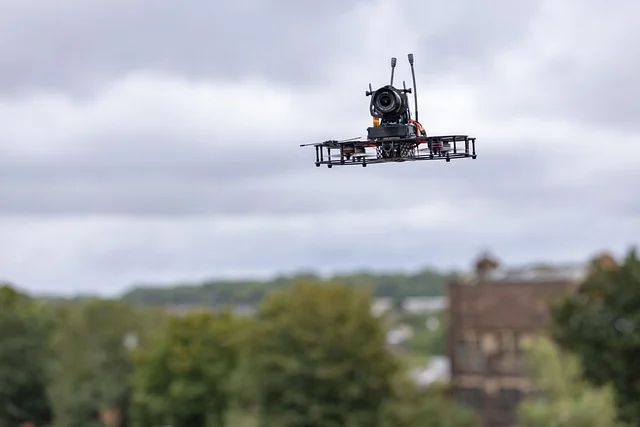
In recent years, drone technology has rapidly evolved, transforming numerous industries and sectors across the globe. Once considered primarily for military applications, drones are now a staple in fields ranging from entertainment to agriculture, logistics, and beyond. With innovations in design, functionality, and autonomy, drones have gained widespread use, proving indispensable in various operations. This article delves into the technology behind drones, their applications, and their impact on modern industries.
Understanding Drone Technology
A drone, also known as an Unmanned Aerial Vehicle (UAV), is an aircraft that operates without a human pilot onboard. Drones can be controlled remotely by a human operator or operate autonomously using pre-programmed flight paths and advanced software, including artificial intelligence (AI). Drones vary significantly in size, capabilities, and functions, from small hobbyist quadcopters to large military-grade systems.
Key Components of Drone Technology
- Flight Control System (FCS): The FCS is the brain of the drone. It stabilizes the drone during flight, adjusts its trajectory, and processes commands from the remote controller or onboard AI system.
- Propulsion System: Drones are usually powered by electric motors connected to propellers or rotors. Quadcopters, for instance, use four rotors to provide lift and maneuverability.
- GPS and Navigation: Most modern drones are equipped with GPS systems that allow them to pinpoint their location and follow precise flight paths. This feature is essential for mapping, surveying, and autonomous flying.
- Sensors and Cameras: Drones are often outfitted with a variety of sensors, such as infrared, thermal, and LiDAR sensors, as well as high-definition cameras. These tools are crucial for applications like surveillance, environmental monitoring, and cinematography.
- Communication System: Drones rely on radio frequencies to communicate with a remote controller or ground station. Some advanced systems use satellite links for communication over long distances.
The Evolution of Drone Technology
Drone technology has come a long way since its initial conception. The earliest drones were designed for military purposes in the early 20th century. However, it wasn’t until the 1990s and early 2000s that drones began to see widespread use in civilian industries. Advances in miniaturization, battery life, AI, and remote sensing technology have driven this change. Today, drones are becoming more affordable, reliable, and easier to operate, contributing to their growing popularity.
Autonomous Drones and Artificial Intelligence
One of the most exciting advancements in drone technology is the integration of AI and machine learning. Autonomous drones, equipped with AI algorithms, can perform tasks without human intervention. These drones can learn from their environment, adapt to changing conditions, and complete complex missions like obstacle avoidance, precision agriculture, and search-and-rescue operations.
Drone Applications Across Industries
Drones have proven to be highly versatile, finding applications across various industries and sectors. Here are some of the most significant uses of drones:
1. Agriculture
Drones are revolutionizing modern farming practices by providing farmers with real-time data about their crops and land. Equipped with multispectral cameras and sensors, drones can:
- Monitor crop health and detect disease or pests early on.
- Map fields for irrigation planning and land optimization.
- Perform precision spraying of fertilizers and pesticides.
Farmers can save time, reduce costs, and increase yields by using drones to gather actionable insights about their crops.
2. Aerial Photography and Videography
Perhaps one of the most well-known uses of drones is in photography and videography. Drones equipped with high-definition cameras have transformed the way we capture aerial footage, whether for film production, real estate marketing, or events such as weddings. They provide unique angles and perspectives that would otherwise require expensive equipment like helicopters.
In addition to cinematic use, drones are becoming essential for media coverage, enabling journalists to capture live footage from hard-to-reach locations during natural disasters or large-scale events.
3. Logistics and Delivery
The logistics industry is another sector poised to benefit from drones. Major companies like Amazon and UPS are exploring drone delivery systems to transport goods, especially in areas with challenging infrastructure or during urgent deliveries. Drones can carry packages, medical supplies, or other items over short distances, reducing delivery times and operational costs.
In disaster relief operations, drones have been used to deliver medical supplies to remote or inaccessible areas, making them life-saving tools in emergencies.
4. Surveillance and Security
Drones have become indispensable in the field of security and surveillance. Law enforcement agencies use drones for:
- Monitoring large public events to prevent crime or manage crowds.
- Conducting surveillance operations without risking the safety of personnel.
- Tracking suspects or providing real-time updates during critical situations.
Private companies are also utilizing drones to safeguard their properties by conducting regular patrols, monitoring perimeters, and alerting security personnel of intrusions.
5. Search and Rescue Operations
Drones equipped with thermal imaging cameras and LiDAR sensors have proven to be incredibly effective in search-and-rescue missions. These drones can:
- Cover large areas of difficult terrain more quickly than human search teams.
- Detect body heat signatures in low-visibility conditions, such as at night or during natural disasters.
- Provide real-time feedback to rescuers, improving the chances of finding missing persons or delivering medical supplies to those in need.
6. Environmental Monitoring and Conservation
Conservationists and environmental scientists are using drones to monitor ecosystems, track wildlife, and detect environmental changes. Drones equipped with sensors can:
- Monitor deforestation, illegal logging, and poaching activities in real time.
- Assess the health of ecosystems, such as coral reefs, forests, and wetlands.
- Collect data on animal populations, migration patterns, and habitats.
These applications are helping researchers to conserve and protect endangered species and ecosystems with greater accuracy and efficiency.
7. Infrastructure Inspection
Drones are becoming a go-to tool for inspecting critical infrastructure such as bridges, power lines, wind turbines, and oil rigs. Equipped with high-definition cameras and sensors, drones can:
- Perform visual inspections without the need for scaffolding, cranes, or other heavy equipment.
- Identify cracks, corrosion, or other structural issues before they become critical.
- Minimize risks to human workers, especially in hazardous environments such as offshore oil platforms.
Regular drone inspections can extend the lifespan of infrastructure and reduce maintenance costs.
Challenges and Limitations of Drone Technology
While drone technology has made significant strides, there are still challenges and limitations that need to be addressed for broader adoption.
1. Regulation and Legal Concerns
One of the primary hurdles for widespread drone use is regulation. Different countries have different rules regarding drone usage, especially in crowded urban areas, near airports, or for commercial purposes. Many governments require drone operators to have special licenses or permits, and there are restrictions on flight altitude and no-fly zones. Ensuring that drones comply with legal standards can be a challenge, especially as drone technology continues to evolve.
2. Battery Life and Payload Capacity
Most drones currently rely on lithium-polymer batteries, which limit their flight time to around 20-40 minutes. This constraint makes it difficult to use drones for long-range missions or extended operations without frequent recharging or battery swapping. Additionally, the payload capacity of drones is limited, meaning they can only carry small packages, cameras, or sensors. Increasing battery efficiency and payload capabilities will be key to future drone applications.
3. Privacy Concerns
The widespread use of drones, particularly in public spaces, raises concerns about privacy. Drones equipped with high-resolution cameras can inadvertently capture footage of individuals without their consent, sparking debates about the ethical implications of drone surveillance.
The Future of Drone Technology
As drone technology continues to evolve, its future is filled with exciting possibilities. Innovations in battery technology, AI, and automation will likely lead to drones with extended flight times, increased autonomy, and more complex functionalities. We may see swarms of drones working together in agriculture, disaster relief, or urban delivery systems.
In urban environments, “drone highways” could become a reality, where designated airspaces are set aside for drone transportation, allowing efficient and safe navigation above cities. This could lead to faster package deliveries and even personal transportation via flying taxis.




